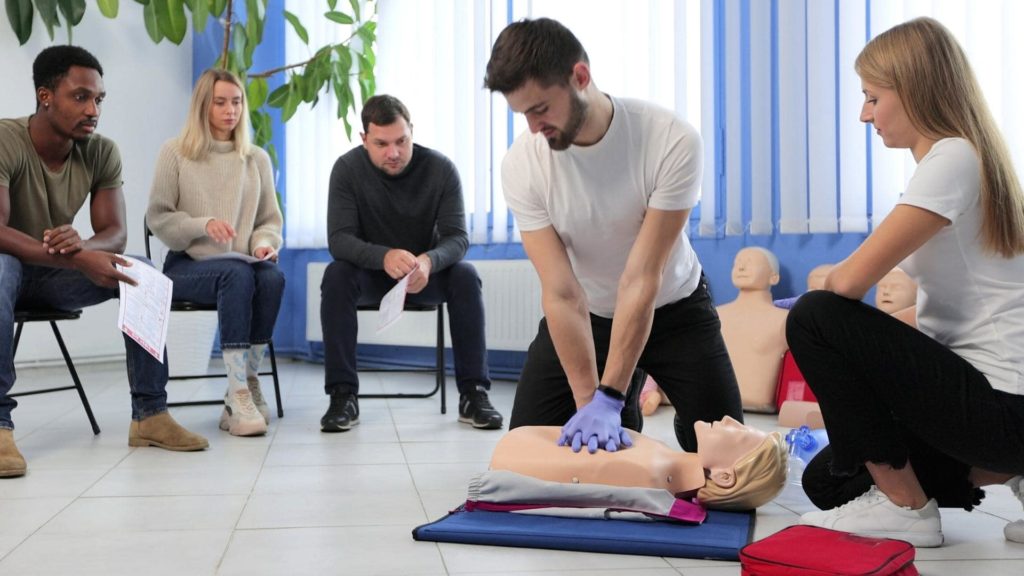Situations where people are hurt or experience a sudden incapacity to breathe can happen at the most unexpected times and places. CPR and First Aid classes prepare you to deal with any unforeseen situations by providing you with the correct knowledge of different lifesaving skills.
You may be wondering, “What Exactly will I learn from CPR and First Aid class?” is one of the many questions that come to mind when thinking about first aid training, so let’s dive into it!
Difference between CPR and First Aid
CPR and First Aid training are different because they entail different lifesaving skills. If a person is suffering from cardiac arrest, CPR is applied to assist them until help arrives. On the other hand, a person who is injured requires first aid assistance.
Skills and knowledge acquired with CPR Training
CPR/AED training prepares you for your role as an emergency service provider
1. CPR Laws and Safety
During the training, you are taught to watch for the signs of various health conditions such as heart disease, stroke, etc. Courses also teach you how to assess the situation if the person is unresponsive. You can expect to learn the universal precautions that are essential in any emergency and how to take personal safety measures when attending to someone.

Part of the training includes learning laws to protect a victim as well as yourself. You will learn when to provide care, how to check if a scene is safe and how to direct bystanders for additional assistance. During CPR training, you learn the skills required to ensure you practice the chain of survival and the Good Samaritan regulations. You are also taught how to work alone or in a coordinated team.
2. CPR Knowledge
There are several different types of CPR/AED courses available to choose from. In-depth training is aimed to help you understand the importance of CPR and how it is administered. The information offered covers how proper CPR restores breathing and blood circulation to save lives. Students will learn how to administer CPR using hands and rescue breaths and working together with a team to provide CPR with the use of an AED (automated external defibrillator).
Most importantly, you learn how to apply CPR according to the age of the victim. CPR/AED Level C training includes learning how to perform CPR on all age groups, including infants. CPR/AED Level A, on the other hand, only teaches you how to perform CPR on adults.
Inquire about CPR Training
Do you have questions regarding CPR training? Contact us today! Our customer service representatives are ready to assist you.
3. Treat Choking Victims with CPR
During your CPR training, you will learn how to treat choking victims who are either in a conscious or unconscious state. You are also taught how to offer help to choking victims of different ages as methods are different for infants and adults.

4. Using an AED
Using an Automated External Defibrillator (AED) is included in every CPR course. You are taught how to operate the device and when to use it. During your CPR/AED Level C class, you learn how to use the AED on infants, children, and adults.
First Aid training
There are two types of first aid courses that you can choose to take: Emergency First Aid & CPR/AED Level C or Standard First Aid & CPR/AED Level C. Each training course covers important life-saving skills, although Standard First Aid is a higher level of training and includes additional material.
In a first aid class you are taught how to recognize and manage different first aid situations, including stroke, broken bones, bleeding, hypothermia, frostbites, heat-related illness, seizure, muscle injuries, poisoning, burns and more. Learn how to control the condition suffered by the victim and how to offer relief.

During the first aid class, you will also learn how to assess the mental state of accident victims and how to move a patient to a safer place during an emergency. Finally, you learn how to identify a patient who is having difficulty inhaling and how to restore their breathing.
Once your training is complete, you will know how to handle various types of emergencies. Use your skills to help relieve suffering or further injuries of patients until help arrives.
Final take
Whether you decide to take an Emergency First Aid CPR/AED or a Standard First Aid CPR/AED course, you will be taught enough important life-saving skills to confidently assist a victim during an emergency.
Register for First Aid Training!
We have 24 locations across Canada, find out which facility is closest to you and enroll today!




















No comment yet, add your voice below!